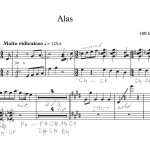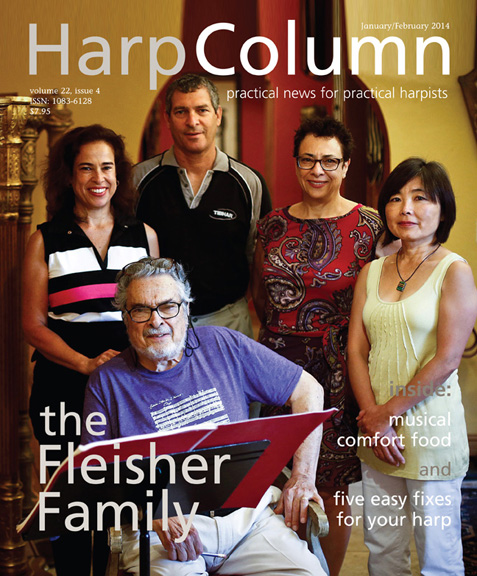- The Good… Neat, tidy, and clear, the markings in this excerpt make it easy for any harpist to know exactly what to do.
- The Bad… The markings in this excerpt are enough to make your skin crawl. It’s better to get an unmarked part than a part with confusing and messy markings like these.
Save yourself and your colleagues headaches from rental parts.

“We’re all on the same team here, and leaving an unintelligible mess for the next harpist will come back to haunt you eventually,” says Elizabeth Volpe Bligh.
When you rent—whether it’s a car, a beach house, or even a harp—you are at the mercy of the previous renters. What you have to work with can be less than ideal—beat up, messy, poorly maintained. The same is true when it comes to rental music.
Rental parts comprise much of the music we play in large ensembles. Often the parts are marked so poorly that the beleaguered harpist has to cast about for a good eraser and a handkerchief into which to sob—but it doesn’t have to be that way.
We’re all on the same team here, and leaving an unintelligible mess for the next harpist will come back to haunt you eventually. The next person who gets that mess of a part might be you, your student, or even your appalled teacher.
So for the common good, I offer some guidelines for marking rental parts.
[protection_text]
Always use erasable black lead pencil—no reds, greens, or blues. You can use black pen only to correct a mistake in the part, making sure it is legible and the same size and font as the surrounding music. Be sure that it is a mistake. Sometimes there are mistakes in the score too, so double and triple check before correcting your part in pen.
Clearly mark pedal diagrams in an obvious location at each rehearsal number or letter and at each main entrance. They should never be floating halfway between two staves. Check that the previously marked diagrams are correct. Sometimes they are wildly wrong.
Pedal changes should be marked in capital, printed letters, not stylized, flowery writing. Any added rests or accidentals should be placed where they belong, and in a standard font. Huge markings can make the page look messy, but tiny markings are impossible to read in bad light, especially by older harpists. Do not pencil anything on top of dynamics or notes, for obvious reasons.
Most North American harpists prefer that pedals be written with the right-side pedals above the left. Pedal markings are written beside each other if they are on the same side of the harp, (e.g., pedal changes D and B should be written beside each other, not one on top of the other).
Do not write anything cryptic. For example, “x” may mean “important” to one person, but “tacet” to another. Most harpists don’t own an “Enigma” decoding machine. Write “solo” over the exposed parts and “covered” over the obliterated parts.
No redundancies! If the time signature is in three, don’t write a circled 3 in the bar. If it is to be conducted in three, write “in 3.” If you write in beats, put them in lightly, lined up with the actual beats. They should not penetrate the next staff nor bisect notes and dynamics.
Mark pedal changes only once and only as necessary. Key changes do not require you to change all the pedals. Mark the pedals in the rests, so you are not dancing flamenco while playing. Write them in immediately after each section, not halfway between two sections or before the beginning of the next section. If your foot was just on a D, then start the next set of changes with that pedal and write them in the easiest order for your feet to get to. If they are changed as you play, there should be no doubt as to which bar or beat they refer to.
Split spans of tacet bars into phrases, (i.e. an eight-bar tacet may have a phrase of five bars, followed by a three-bar phrase, marked 5 / 3. Add clear cues, such as “m5 trpt.” (measure 5, trumpet). Writing “5th”, with nothing after it, is puzzling. 5th column? 5th estate? 5th of scotch? Another unclear cue is “Bob, bar 5.” Don’t ask me how I know.
To take panic out of page turns, write the number of bars coming up on the bottom-right outside edge of the page and the number of bars from the last page on the top-left corner of the next. Write “V.S.” if you have a really fast page turn. For impossible page turns, transcribe the next few bars onto the bottom of the page or affix an insert that has everything on one page, so that you avoid catastrophe.
Minimize pedal changes by using enharmonics (e.g. when you are going from a flat key to sharps and back to flats.) If this is the case, it is best to write an insert rather than muddle up the part with a slew of enharmonics. If there are only one or two enharmonics, circle them and pencil in the actual note beside the circled one.
When there are repeated bars, number each bar and circle the last number. Add cues to help with the counting.
Circles should not be overused (e.g. time signatures do not require circling).
If measure numbers are infrequently marked, put them at each multi-rest. When the conductor abruptly starts at bar 132, you will have an easier time finding your entrance.
Rather than cringing when opening a rental part, if we all take the time to properly mark our scores, we can all heave a sigh of relief! •
Elizabeth Volpé Bligh has been the Principal Harpist of the Vancouver Symphony Orchestra since 1982 and is Sessional Harp Instructor at the University of British Columbia and the VSO School of Music. She was Chair of the 11th World Harp Congress Host Committee in 2011 and co-founded Canadian International Summer Harp Institute. Her articles can be downloaded from her web site www.elizabethvolpebligh.com








